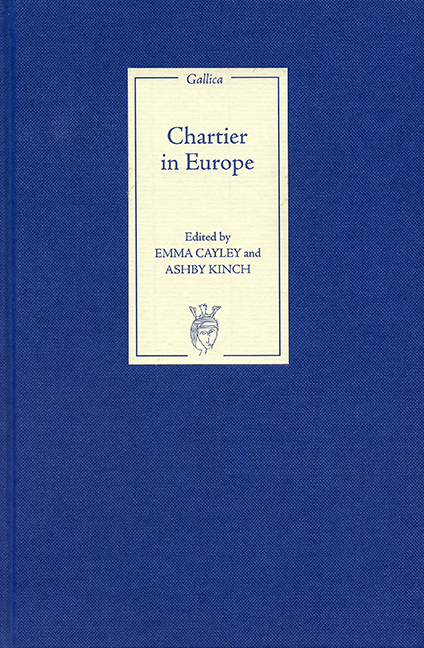Book contents
- Frontmatter
- Contents
- Foreword
- List of Contributors
- Acknowledgements
- List of Abbreviations
- Introduction
- Part I Authorising Chartier
- 1 Boethius as Model for Rewriting Sources in Alain Chartier's Livre de l'Esperance
- 2 ‘Vox Dei, vox poetae’: The Bible in the Quadrilogue invectif
- 3 ‘Car rompre vault pis que ployer’: Proverbial Pleasure in La Belle Dame sans mercy
- 4 Alain Chartier's Livre des Quatre Dames and the Mechanics of Allegory
- Part II Transmitting Chartier
- Part III Translating Chartier
- Bibliography
- Index
- Miscellaneous Endmatter
1 - Boethius as Model for Rewriting Sources in Alain Chartier's Livre de l'Esperance
from Part I - Authorising Chartier
Published online by Cambridge University Press: 24 October 2017
- Frontmatter
- Contents
- Foreword
- List of Contributors
- Acknowledgements
- List of Abbreviations
- Introduction
- Part I Authorising Chartier
- 1 Boethius as Model for Rewriting Sources in Alain Chartier's Livre de l'Esperance
- 2 ‘Vox Dei, vox poetae’: The Bible in the Quadrilogue invectif
- 3 ‘Car rompre vault pis que ployer’: Proverbial Pleasure in La Belle Dame sans mercy
- 4 Alain Chartier's Livre des Quatre Dames and the Mechanics of Allegory
- Part II Transmitting Chartier
- Part III Translating Chartier
- Bibliography
- Index
- Miscellaneous Endmatter
Summary
Qui publicis curis mentem
animumque dederat jam se ipsum
exuens universalem virum induit,
non homo unus, sed omnis in
omnibus effectus.
Recently attention has begun to focus on how an antecedent work serves as a model rather than as a source stricto sensu for a new work. A source fits the usual meaning of the word in scholarship: that of a work a subsequent author draws on for matière. A model is different. A model in the sense I am using the term refers to a work with commonplace features that the new author uses as a pattern or frame for the work he or she writes. Boethius's Consolation of Philosophy is the model for Chartier's Livre de l'Esperance. Both these writings illustrate the prosimetrum, or a work in both verse and prose. In each, personifications lead a despairing author figure, named Acteur in the Esperance, towards consolation and, more importantly, truth and selfknowledge. However, unlike Boethius, Chartier's sources are not only philosophical. In fact, Philosophy is rejected in the Esperance because it leads to despair and suicide. Chartier's major sources are the Bible and Church authorities; they provide faith, hope, and charity. In the Esperance, then, Chartier uses Boethius as model, while drawing on biblical and patristic sources as well as some secular authors. In what follows, when appropriate, I suggest comparisons with his other writings and with the works of other medieval authors.
According to Thomas Haye, a model identifies and shows the medieval author's awareness of generic features. Such features are found in specific works that identify the model as archetypus or ‘blueprint’ of the work in the artist's mind. Such works were perceived as arts of poetry because they contain features of the art that the student and later writer could imitate or emulate. In terms of medieval poetics, we may speak of the model as the archetypal blueprint that the new author uses to elaborate and amplify new sources – in Chartier's case, the Bible; Christian works that Boethius implicitly left out of his Consolation in favor of Philosophy; and standard secular authorities. Awareness of the model as a blueprint that the new author reconstrues using new sources obliges us to consider how the author proceeds in individual cases in which he or she rewrites a given model, as, for example, Chartier does in his Esperance.
- Type
- Chapter
- Information
- Chartier in Europe , pp. 15 - 30Publisher: Boydell & BrewerPrint publication year: 2008



